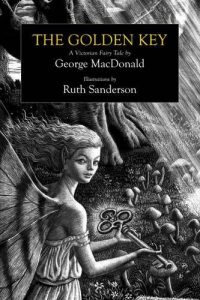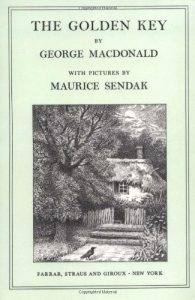Meeting George MacDonald
I first met George MacDonald through the pages of his poetry and then, later, in his novels (the versions edited by Michael Phillips). I much preferred his poetry to his novels.
And then I discovered his fantasy.
I promptly told my college thesis advisor that I wanted to write my senior thesis on George MacDonald’s fairy tales. His first direction to me: “Read all of George MacDonald’s stories for children, and then come up with your thesis.”
And so I did. My favorite story at the time was The Wise Woman (also known as The Lost Princess). I also enjoyed The Princess and the Goblin and The Princess and Curdie.
It was only later that I began to appreciate stories like The Golden Key.
The Golden Key

At the beginning of The Golden Key, Mossy hears his great-aunt tell him of the golden key and fairyland (which lay just outside their yard). Captivated by the idea of the golden key, Mossy sets off to find it at the rainbow’s edge. He finds the key but no keyhole. Simultaneously, Tangle, a poor mistreated child, also sets off on a journey, but she is fleeing her circumstances, rather than seeking a goal. The fairies are mistreating her and causing her fear.
The two children meet up in the home of a “grandmother” (not their own, but the recognizable old woman that shows up in many of MacDonald’s stories). She nourishes them and prepares them for their coming journey to find the keyhole for Mossy’s golden key. She reminds them to continue pressing forward, even if they get separated.
And so follows a very strange tale. At first, the two travel together, looking for the land from whence the shadows fall (and also for the keyhole). Tangle’s story is told first: she meets progressively older men who help her get to the next stage of her journey (the Old Man of the Sea, the Old Man of the Earth, the Old Man of the Fire), but each appears younger and younger to her eyes.
When she meets up with Mossy again, they have each lived lifespans, and are old and gray. And yet, they are young again, too, and beautiful. They turn the golden key in a keyhole and begin climbing the rainbow to the land from where the shadows fall.
Which Version of The Golden Key?
This story appears in many collections of MacDonald’s works, but there are several notable stand alone picture book versions. The small version illustrated by Maurice Sendak (who also illustrated The Light Princess) will delight small hands and provide a satisfying introduction to this story. Black and white drawings echo Sendak’s style, but they are more classic than Sendak’s art in books like Where the Wild Things Are.
More recently, Ruth Sanderson (one of our professors in graduate school*) illustrated The Golden Key. We’re a bit partial, perhaps, but this latest is a very interesting look at MacDonald’s tale. Black and white, like Sendak’s, Sanderson’s art is far more lush and extravagant. Many illustrations are full page, or even double spreads. The effect is simultaneously more substantial and more wild than Sendak’s treatment. The people pictured look very much like real people, but the surroundings echo the various landscapes Mossy and Tangle travel through (the land of shadows is especially effective).
*Megan and I earned our MAs in Children Literature together at Hollins University.
The reader will have to decide if he or she prefers an illustrated version or wants the tale to stand on its own. There’s benefit to either approach!
Some of MacDonald’s Beliefs

The Golden Key includes so many of MacDonald’s beliefs that it forms a great introduction to his work. One of the most significant is that we must become like little children to have faith. As the old men in the story grow progressively younger in their outer appearance, so we must, too, grow more and more like little children as we simultaneously grow wiser. But even the strange flying fish and other elements of this story crop up in MacDonald’s poetry (read the first few stanzas of his Diary of an Old Soul for an example of his imaginative symbols and the importance of child-like faith).
Anyone who has read The Princess and the Goblin or At the Back of the North Wind will recognize the wise woman character (she is often called, simply, “Grandmother”). This person acts like the “God-figure” in MacDonald’s tales and represents the all-seeing, all-knowing, nurturing elements that many of the Psalms portray about God. For instance, think of the images of a hen gathering her chicks. She knows what is best for the children in her care, even when it may cause them pain. In The Princess and the Goblin, she is linked by a silver thread to Irene and Curdie, always guiding them home to her. She is only found by those who seek her, and she chooses to whom she will reveal herself.
MacDonald’s Influence on C. S. Lewis and the Inklings
C. S. Lewis famously said that George MacDonald baptized his imagination. But C. S. Lewis also talked about the idea of “Shadowlands” (there’s even a film about Lewis called Shadowlands in reference to this). Perhaps The Golden Key was part of Lewis’s inspiration for this idea? The Shadowlands crop up in several of his works, although The Great Divorce portrays heaven as solid and earth as the shadow.
So much of our contemporary Christian fantasy owes a debt to the Inklings (Tolkien, Lewis, Sayers, Chesterton, Williams, etc.), but we forget that the Inklings owed much of their inspiration to George MacDonald. He was one of the first–and arguably, one of the best–to write stories for children and to fill his stories with such transparent spiritual parallels.
Our Golden Key Fellowship
It is in homage to writers like George MacDonald and those who followed him that we named our new membership “The Golden Key Fellowship.” We admire their attempts to use story to tell the Story, to infuse their literary works with Truth. Were they perfect? No. But, their work draws us ever onward, does it not?
Related Reading from Redeemed Reader:
Have you read much of George MacDonald? The Golden Key? Which story is your favorite?
Tell us in the comments!
We are participants in the Amazon LLC affiliate program; purchases you make through affiliate links like the ones below may earn us a commission. Read more here.
Stay Up to Date!
Get the information you need to make wise choices about books for your children and teens.
Our weekly newsletter includes our latest reviews, related links from around the web, a featured book list, book trivia, and more. We never sell your information. You may unsubscribe at any time.
Support our writers and help keep Redeemed Reader ad-free by joining the Redeemed Reader Fellowship.
Stay Up to Date!
Get the information you need to make wise choices about books for your children and teens.
Our weekly newsletter includes our latest reviews, related links from around the web, a featured book list, book trivia, and more. We never sell your information. You may unsubscribe at any time.
We'd love to hear from you!
Our comments are now limited to our members (both Silver and Golden Key). Members, you just need to log in with your normal log-in credentials!
Not a member yet? You can join the Silver Key ($2.99/month) for a free 2-week trial. Cancel at any time. Find out more about membership here.
